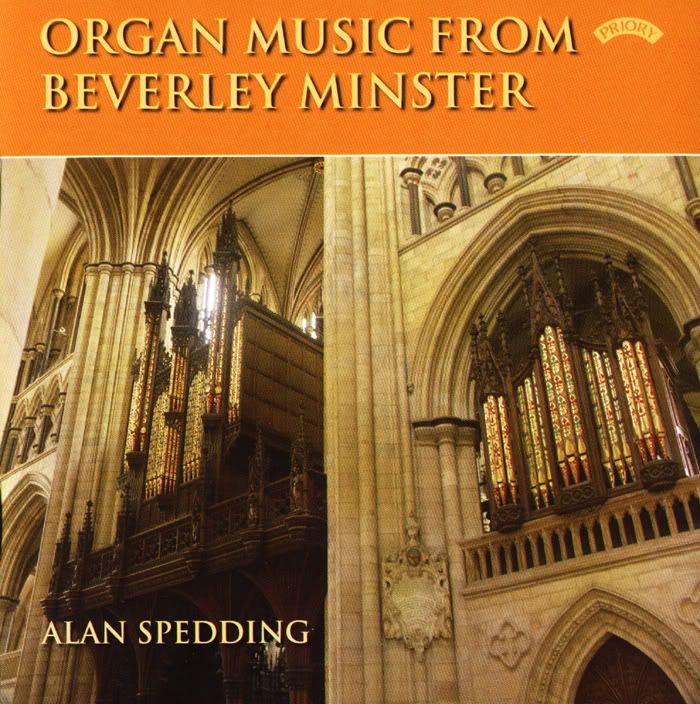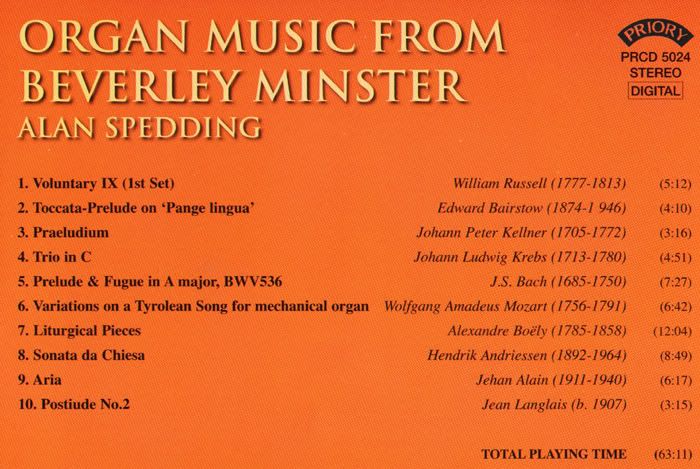 |
| NetLab · Rules · Torrent Tracker · Have a problem? · Eng/Rus |
 Help Help
 Search Search
 Members Members
 Gallery Gallery
 Calendar Calendar
|
| Welcome Guest ( Log In | Register | Validation ) | Resend Validation Email |
|
Posted: 20-08-2008, 20:33
(post 1, #852383)
|
||||||||||||||||||
|
Pro Member Group: Members Posts: 695 Warn:0% |
Organ Music from Beverley Minster Label: Priory, PRCD 5024 Year: 1990 Performer: Alan Spedding - organ This CD is a fine mix of music from a wide variety of eras, countries and styles. The opening piece is a rather good 18th century Voluntary by the London-based composer William Russell. He was one-time piano player and in-house composer for Sadler’s Wells and Covent Garden. He was also organist at the magnificent Hawksmoor Church at St. Anne’s Limehouse - which I can see from my office window. This Voluntary - which has a powerful opening 'largo' followed by a robust fugue is a good example of the genre that surely deserves more than an occasional airing. Edward Bairstow is eternally associated with York Minster where he was organist for many years. The Toccata-Prelude was published in 1911 when the composer was organist and choirmaster at Leeds Parish Church. Interestingly, for the period, the work is written in 5/4 time. The liturgical inspiration for this work is the plainsong melody set to the words 'Sing, my tongue the Glorious Battle' which proudly proclaims the Resurrection of Christ. The work balances triumph and reflection before "the music melts away in an atmospheric ending". Johann Peter Kellner was an admirer of J.S. Bach and was an early scholar of that composer's music. In fact he copied a number of the master's organ works and these are regarded as being amongst the most reliable source documents for these pieces. The Praeludium is a great powerful work that is beholden to the elder composer. Johann Ludwig Krebs was one of Bach’s finest pupils: he studied with him for nine years. His Trio in C is a restrained and subtle tribute to his teacher’s art. As part of good programming on this CD the Prelude and Fugue in A major by J.S Bach is an example of Kellner’s industry: this work is only available to us because he copied his teacher's music. The original manuscript has been lost. This is a great work that impresses and entertains from the first note to the last. I have never been a big fan of Mozart's organ music; however this work is actually rather impressive. It originated as a barrel-organ piece, the Variations on a Tyrolean Song: musicologists are undecided as to whether it is actually by Leopold or Wolfgang Mozart. There is considerable musical interest here -and predictably the music becomes more complicated as the work progresses. How the organist gets his fingers around the 'mechanical' scales I will never know? The longest work on this CD is the Liturgical Pieces by Alexandre Boely. This composer had imbibed the influence of Haydn and Mozart a well as Bach and Frescobaldi. In fact, he is credited with the introduction of Bach's music to Paris. These liturgical pieces were composed to accompany various 'events' in the celebration of the Mass. Boely's music is strong and powerful and reflects the majesty of the Eucharist. However the programme notes relate that he was sacked from his organ post because he was not prepared to play and compose music to "reflect the frivolities of the salon and theatre." Irony indeed! I was impressed by the Sonata da Chiesa by the Dutch composer Hendrik Andriessen. It is written in an eclectic style. In the first bars one is reminded of Cesar Franck - however as the ‘theme, five variations and finale’ progresses the music becomes increasingly more 'modern' in its soundscape without ever losing its grounding in the 'romantic' tradition. This is a masterpiece. Jehan Alain was one of the great musical losses of the Second World War. Most listeners are acquainted with the ubiquitous Litanies. Yet the beautiful Aria offers the listener another, more introverted, side of the composer. This complex work exploits the Alain fingerprints of "irregular rhythms, swaying oriental themes" and a wide range of the organ's colours and textures. The CD closes with a fine work by the organist and composer Jean Langlais. The Postlude No.2 is a bold and precipitate toccata that balances slow 'largo' passages with complex highly technical figurations. Spedding creates some inspiring registrations for this work. It is a great work for the recessional after Holy Eucharist on High Days and Holydays- and to conclude the present CD. Beverley Minster organ is a fine instrument that has its origins in a Johann Snetzler organ built in 1769. The present instrument has had rebuilds by Forster & Andrews, Hill, Norman and Beard and latterly Wood. Alan Spedding provides a technically superb and highly imaginative performance of all these works. He has chosen a good programme that balances old with new, English and Continental music. Tracklist: 01. Voluntary IX (1st Set) William Russell (1777-1813) (5:12) 02. Toccata-Prelude on Pange lingua Edward Bairstow (1874-1 946) (4:10) 03. Praeludium Johann Peter Kellner (1705-1772) (3:16) 04. Trio in C Johann Ludwig Krebs (1713-1780) (4:51) 05. Prelude & Fugue in A major, BWV536 J.S. Bach (1685-1750) (7:27) 06. Variations on a Tyrolean Song for mechanical organ Wolfgang Amadeus Mozart (1756-1791) (6:42) 07. Liturgical Pieces Alexandre Boely (1785-1858) (12:04) 08. Sonata da Chiesa Hendrik Andriessen (1892-1964) (8:49) 09. Aria Jehan Alain (1911-1940) (6:17) 10. Postiude No.2 Jean Langlais (b. 1907) (3:15) TOTAL PLAYING TIME (63:11)   LOG
This post has been edited by kgkk on 03-05-2012, 11:17 |
||||||||||||||||||
|
|||||||||||||||||||
|
|
||
|
proRock Group: Netlab Soldier Posts: 25100 Warn:0% |
Вот! Ну наконец! Так должен звучать ОРГАН!!! kgkk, огромное спасибо! А то я уж думал у меня расстройство ушей... |
||
|
Posted: 03-05-2012, 11:18
(post 3, #1052914)
|
||
|
Pro Member Group: Members Posts: 695 Warn:0% |
Я залил снова ето торрент. |
||


Powered by Invision Power Board v1.3.1 Final.

